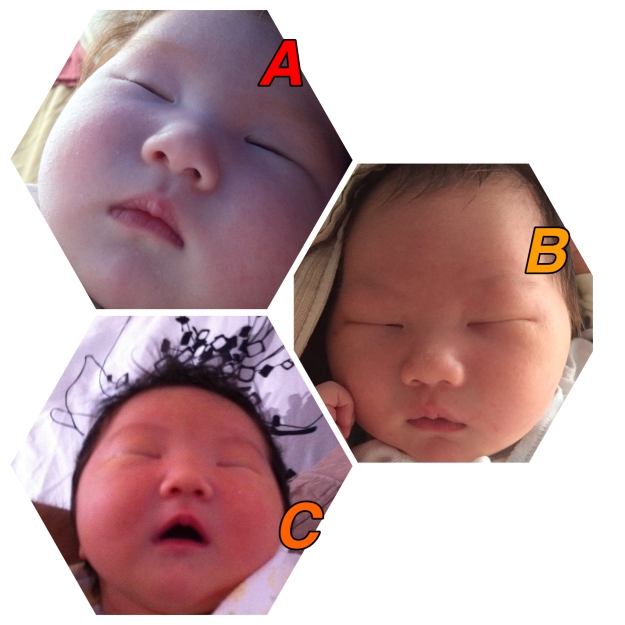Our gentle Nina is a sensitive soul and often struggles with emotions running like a tornado through her head. We’ve been working with her to express her feelings so that we can help her put things into perspective, but she still struggles to simply describe how she feels. Her vocabulary is still pretty limited and she can’t fully verbalize what she is experiencing.
To help, I ordered a book from the US called “The Rainbow Book” by Kate Ohrt. I had first read about it here. I’ve always been fascinated by paper cutouts. I also like the idea of associating colors with simple yet descriptive words to help children identify their feelings when they get hit by that emotional tidal wave.
What I love about this book is that all the words are positive. For example, in the kids movie Inside Out, Anger is the red square guy. In this book, however, red is associated with “fiery” and “bold” instead of “angry.” So I had the chance to talk to Nina about exactly how she felt about her first day of school, or after a fight with Mila.
Once I introduced her to the book, I’ve also used the colors as somewhat of a booster for her to calm herself down. When Nina started her new school, she was nervous. No surprise there. She wanted us to stay with her. Instead, I gave her a blue “diamond” from her toy box to take with her to school to keep in her pocket. In the book, blue is described as “calm and peaceful” and I told her that when she feels nervous, angry, or lonely, she should squeeze the diamond, think calm thoughts and imagine the color in her head.
First day, she told me it didn’t help. She kept squeezing the diamond, but it didn’t do anything. I told her, well, if you don’t need it, then that’s good, but keep it handy so that when you do, it’s there. She kept taking it to school.
One day, on our way back, she said, “Mommy, today, in the afternoon, I felt really angry. This kid said mean things to me. Then I tried to find the diamond, but it was in my other shorts (pocket). But then, I tried to think think think of blue and calm and breathe and I felt better!”
Now, when she’s angry or nervous or, in fact, when I’m angry, she’ll come to me and say, “I want to be blue, I like blue.” Then both of us can take the time to calm down ’cause you know what, sometimes, it’s me that needs that reminder and not her. I’m the one seeing red and I need to remember that somewhere, I’ve got blue in me.
I’m always looking for new ways to communicate with my kids other than throwing sarcasm and crass comments – it’s who I am, and it ain’t gonna change. If you are one of those parents that just need a different way to communicate with your child, then this book is a great way to introduce emotional concepts in an easily-relatable form.
私は感情的な話が苦手。親、母親といえば、深~い愛情とほっこりした笑顔で子供を迎えて、導いてあげるこそが至高、(そしてもちろん美しくしろって)とされてる今の子育てが窮屈で仕方ない。子供の感情に寄り添ってあげなくてはいけないのなんて、百も承知、でもいつも、笑顔を浮かべて、優しく諭し、寄り添い、抱きしめてあげる、なーんて、出来ない。ついつい皮肉だったり、現実的なコメント(子供に言ってもしょうがないだろ、的な)が出る。そういう親だっている。私以外にも。
多分。
でも子供と歩み寄ろうとする気持ちはあるよ、もちろん。ただ素敵ママにはなれないってだけ。そしてどんなママでもきっと子供とシェア出来る、と自信を持ってお勧めするのが、The Rainbow Book by Kate Ohrt。残念ながら、現時点では日本語訳は出てないようです。が、簡単な英文で描かれているし、何より見てて落ち着くし、目に楽しい本なので、素敵ママにも英才教育ママにもおススメ。
感情を伝えるって、とても難しいけれど、色で見ると分かりやすい。この本は、皆の持っている色々な感情をシンプルな英語と切り絵をマッチさせて表現しています。だから子供でもとても分かりやすい。一つの色に二つの言葉がリンクしてあります。それもマイナスなイメージのある言葉を使用していないのも魅力。
例えば、赤を感情で表す、というと、恐らく最初に浮かぶのは「怒り」”Anger”だと思うのですが、この本では、あえて “Bold”「大胆、勇敢」と”Fiery” 「激しい、気性の荒い、という意味合いもあるが、情熱的のようなプラスな意味もある」と、「怒り」のようなマイナスイメージの言葉に収めていないのがいいところ。
こんな風に、全ての色が全体的にポジティブな感情を表す言葉で表現されています。
小さくて、まだ言葉が分からない時は1ページ毎に変わる切り絵を色を楽しんで、もう少し大きくなって来れば、言葉自体の意味を、複雑な感情の出来てくる5、6歳になれば、色で感じた言葉を表現出来るようになったり、自分の気持ちを色に置き換えて説明出来るようになったり。
切り絵のページは、ただ見ていて綺麗なだけではなくて、全てのページを重ねてみると、下の色もみえるようになっていて、感情とは、一つづつ出てくるものではなくて、複雑に重なっているんだ、と思い出させてくれる。そして最後の見開きのページでは、全ての切り絵が一つの虹になって、初めて貴方になるのよ、と全体像を見せてくれる、目にも楽しい絵本です。
子供にもすんなり受け入れられる本なので、応用も出来ます。新菜が新しい学校を始めた時、やはり色々な不安、興奮、など感じているのは分かるのだけど、どうしてあげればいいのか、私も戸惑っていた時。お守りとして、おもちゃの青いダイアモンドを渡して、The Rainbow Bookにあったよね、青は平和な気持ち、落ち着いた気持ちになれる色だよね、だから不安になる事があったら、ダイアモンドをギュッと握って、青い色を思い浮かべてごらん、と言って送り出しました。
結果?初日は、
「全然だめだった、ダイアモンド握っても、だめだったよ」
「とりあえず持って行って、必要だと思ったら使うようにしてみたら?いらなければそれでいいんだし」
「うん、でも役にたたないよ。」
キッパリと否定してきました。(笑)
が、真面目な新菜さんはそれでも毎日忘れないようにダイアモンドを持って行って、頑張ってたんです。そして数週間後。
「ママ、今日ね、嫌なこと言われたの。それでね、ダイアモンド探したんだけど、別のズボンのポケットに入っててね、なかったの。でもね、一生懸命青い色の事考えたの、それで深呼吸したらね、大丈夫だったよ」
なんだかんだ言って、気持ちは伝わってた。そう、大事なのはダイアモンドじゃなくて、本人の気持ちの持ち方。
それ以来、自分の機嫌が悪い時でも、私が怒ってギャーギャー騒いでる時でも、新菜は寄ってきて、「青になりたい、青、好き。」と言ってくれるようになったので、二人で深呼吸するいいきっかけになってます。私も真っ赤になるしね。
この本、早速一月の新菜のお誕生日テーマにさせてもらいました!お誕生日についてはまた後日。
本については、こちら (英語オンリー)
http://booksthathealkids.blogspot.sg/2011/07/book-review-rainbow-book.html

The “Red” Page from the Rainbow Book by Kate Ohrt

Nina’s “diamonds” she takes to school

Mila’s favorite, “Pink” page



